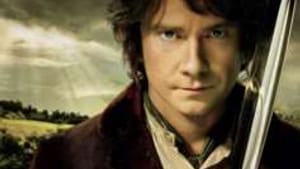Stay in the Loop
BSR publishes on a weekly schedule, with an email newsletter every Wednesday and Thursday morning. There’s no paywall, and subscribing is always free.
Can swords kill people? Oh my yes (and all by themselves, too)
Gun control lessons from "The Hobbit'

If Middle Earth has a standardized education system, what's its core curriculum? In the wake of this month's Connecticut elementary school massacre, Peter Jackson's latest Tolkien adaption, The Hobbit: An Unexpected Journey, provides a dismaying possible answer.
Without some course like Weapons 101, how does every character— from the elves of Rivendell to teeming subterranean goblin hordes— know all those swords by name?
The Hobbit is a long, long movie. And like its cinematic forebears in Jackson's Lord of the Rings trilogy, when the characters aren't waging battle against the masses of Mordor, they're delivering worshipful monologues about weapons.
NRA rallying cry
It's striking that a blockbuster film bursting with paeans to weaponry has hit theaters while America is wracked by its latest round of grief, soul-searching and posturing over guns.
Nevertheless, if you stick with The Hobbit to the bitter end, it turns out that the rallying cry of the National Rifle Association"“ "Guns don't kill people, people kill people""“ wouldn't fly in Middle Earth.
In this prequel to Lord of the Rings, the homebody Hobbit, Bilbo Baggins (Martin Freeman), plays host to Gandalf the Grey (Ian McKellen), an amiable yet inscrutable wizard whose visit is followed by the unexpected appearance of 13 hairy, ravenous dwarfs. Dispossessed from their ancestral home and riches by a dragon, the dwarfs offer Bilbo a percentage of their reclaimed wealth in exchange for his help as "burglar" on their quest. (Hobbits, you see are small enough to pass unnoticed by most dragons and other mortals.)
Swords with personalities
The band sets off to face an eccentric woodland wizard, brutal orc armies, goblin mobs and hungry trolls, not to mention Gollum, a mysterious creature in the depths of the mountain who possesses an extraordinary ring.
Bilbo joins the dwarf king Thorin along with numerous warriors. The sojourners also team up with Orcrist, Glamdring and Sting. But these three characters are not dwarfs, wizards, elves, Hobbits, men, goblins or orcs; they're swords, with titles, histories and personalities of their own. Show a citizen of Middle Earth a sword he'll tell you its maker, its name and its deeds without so much as a handbook.
For example, in The Two Towers— the film based on the middle volume of Tolkien's Rings epic—Bilbo's nephew Frodo defends himself from an ambush by placing the point of his uncle's sword against the assailant's throat.
"This is Sting," Frodo explains. "You've seen it before, haven't you, Gollum?"
Who needs warriors?
The characters' tendency to introduce their weapons as if they were particularly volatile traveling companions leaves the audience wondering whether the villains of The Hobbit or Lord of the Rings would have been driven off so effectively if the weapons themselves didn't have their own power and lore, apart from the wielding warrior's.
In the film conclusion of the Rings trilogy, Aragorn, a king by birth, gains his power only when he grasps an elf-made sword named Anduril, forged from the shards of a historic blade known as Narsil, shattered generations ago when, in the hands of a human king, it defeated Middle Earth's ultimate foe.
The Hobbit similarly maintains this reverence for personified weapons. When a gang of goblins nabs the 13 dwarfs and throws them before the flabby, malicious goblin king, the goblins laugh mockingly at their helpless captives"“ until a disembodied blade clangs into their midst, clearing a panicked circle in the horde.
The apparent moral: Dwarfs don't kill goblins; swords kill goblins.
Gun love on Facebook
The citizens of Middle Earth view their weapons as sentient partners in battle. Their affection for their weapons is not all that different from the NRA supporter who recently declared on Facebook, "I love my guns!"
By the time The Hobbit mercifully concluded its 169-minute running time (and it's only the first of three films planned from Tolkien's relatively slim novel), I'd had my fill of swords, axes, bows, daggers, flaming pine cones and all the other weapons that dominate the film's dialogue and action"“ and that was after I'd been battered by all the debates over firearms outside the theater.
But I can't help wondering: Why can't Americans view guns the way Middle Earth's warriors view their swords: as potent forces in their own right, requiring study and caution, respect and fear, no matter who holds them?.♦
To read responses, click here.
Without some course like Weapons 101, how does every character— from the elves of Rivendell to teeming subterranean goblin hordes— know all those swords by name?
The Hobbit is a long, long movie. And like its cinematic forebears in Jackson's Lord of the Rings trilogy, when the characters aren't waging battle against the masses of Mordor, they're delivering worshipful monologues about weapons.
NRA rallying cry
It's striking that a blockbuster film bursting with paeans to weaponry has hit theaters while America is wracked by its latest round of grief, soul-searching and posturing over guns.
Nevertheless, if you stick with The Hobbit to the bitter end, it turns out that the rallying cry of the National Rifle Association"“ "Guns don't kill people, people kill people""“ wouldn't fly in Middle Earth.
In this prequel to Lord of the Rings, the homebody Hobbit, Bilbo Baggins (Martin Freeman), plays host to Gandalf the Grey (Ian McKellen), an amiable yet inscrutable wizard whose visit is followed by the unexpected appearance of 13 hairy, ravenous dwarfs. Dispossessed from their ancestral home and riches by a dragon, the dwarfs offer Bilbo a percentage of their reclaimed wealth in exchange for his help as "burglar" on their quest. (Hobbits, you see are small enough to pass unnoticed by most dragons and other mortals.)
Swords with personalities
The band sets off to face an eccentric woodland wizard, brutal orc armies, goblin mobs and hungry trolls, not to mention Gollum, a mysterious creature in the depths of the mountain who possesses an extraordinary ring.
Bilbo joins the dwarf king Thorin along with numerous warriors. The sojourners also team up with Orcrist, Glamdring and Sting. But these three characters are not dwarfs, wizards, elves, Hobbits, men, goblins or orcs; they're swords, with titles, histories and personalities of their own. Show a citizen of Middle Earth a sword he'll tell you its maker, its name and its deeds without so much as a handbook.
For example, in The Two Towers— the film based on the middle volume of Tolkien's Rings epic—Bilbo's nephew Frodo defends himself from an ambush by placing the point of his uncle's sword against the assailant's throat.
"This is Sting," Frodo explains. "You've seen it before, haven't you, Gollum?"
Who needs warriors?
The characters' tendency to introduce their weapons as if they were particularly volatile traveling companions leaves the audience wondering whether the villains of The Hobbit or Lord of the Rings would have been driven off so effectively if the weapons themselves didn't have their own power and lore, apart from the wielding warrior's.
In the film conclusion of the Rings trilogy, Aragorn, a king by birth, gains his power only when he grasps an elf-made sword named Anduril, forged from the shards of a historic blade known as Narsil, shattered generations ago when, in the hands of a human king, it defeated Middle Earth's ultimate foe.
The Hobbit similarly maintains this reverence for personified weapons. When a gang of goblins nabs the 13 dwarfs and throws them before the flabby, malicious goblin king, the goblins laugh mockingly at their helpless captives"“ until a disembodied blade clangs into their midst, clearing a panicked circle in the horde.
The apparent moral: Dwarfs don't kill goblins; swords kill goblins.
Gun love on Facebook
The citizens of Middle Earth view their weapons as sentient partners in battle. Their affection for their weapons is not all that different from the NRA supporter who recently declared on Facebook, "I love my guns!"
By the time The Hobbit mercifully concluded its 169-minute running time (and it's only the first of three films planned from Tolkien's relatively slim novel), I'd had my fill of swords, axes, bows, daggers, flaming pine cones and all the other weapons that dominate the film's dialogue and action"“ and that was after I'd been battered by all the debates over firearms outside the theater.
But I can't help wondering: Why can't Americans view guns the way Middle Earth's warriors view their swords: as potent forces in their own right, requiring study and caution, respect and fear, no matter who holds them?.♦
To read responses, click here.
What, When, Where
The Hobbit: An Unexpected Journey. A film directed by Peter Jackson, from the novel by J.R.R. Tolkien. For Philadelphia area show times, click here.
Sign up for our newsletter
All of the week's new articles, all in one place. Sign up for the free weekly BSR newsletters, and don't miss a conversation.
 Alaina Johns
Alaina Johns